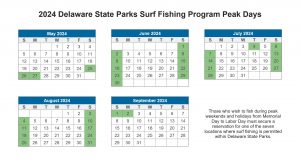Assawoman Canal-White Creek dredging project map. /DNREC graphic
Beneficial Reuse Sediment From Dredging Will Help Restore Nearby Salt Marsh
The Delaware Department of Natural Resources and Environmental Control announced today that two vital dredging projects in southern Delaware are set to begin around the new year. Dredging is to start at the southern end of the Assawoman Canal, and when the canal portion is completed (anticipated for early February 2024), DNREC-contracted dredge crews will move into White Creek resuming a project that is expected to finish by late winter or early spring.
DNREC aims to improve navigability on the two important waterways northwest of Bethany Beach in Sussex County. Dredging on both White Creek and the Assawoman Canal began in early 2023 but was paused for environmental restrictions. Dredged sediment from both projects will be used to restore an area of degraded salt marsh at DNREC’s Assawoman Wildlife Area.
The projects to be undertaken by DNREC’s Shoreline and Waterway Management Section and the contractor McLean Contracting Company of Glen Burnie, Md. will remove approximately 80,000 cubic yards of shoaled sediment from the two waterways. The dredging work will restore White Creek and the Assawoman Canal to previous depths for safer boating and recreational use.
Funding for the $8.48 million project comes from appropriations to DNREC in the fiscal year 2022 and 2023 Bond Bills and the Waterway Management Fund. Both bills cited White Creek and the Assawoman Canal as dredging priorities.
White Creek flows from the south to the north into Indian River Bay, connecting the Assawoman Canal to the Bay, while serving numerous marinas and boat ramps for recreational activities. The White Creek navigation channel was last dredged by DNREC as part of a phased program from 1997 through 2001. The Assawoman Canal was most recently dredged from 2010 to 2015. The eastern and western prongs of White Creek and the confluence of the Assawoman Canal were last dredged in early 2023.
Based on surveys of residents and recreational users of the waterway and analysis of channel depth, boater safety and environmental issues, DNREC identified White Creek and the Assawoman Canal as two of the top priorities for navigation improvements.
For White Creek, an area 60 feet wide and 12,400 feet long is to be dredged – from the mouth of the creek, at Indian River Bay, to where the main channel splits into two prongs near Betts Avenue, in Ocean View. The eastern prong of White Creek was dredged 2,650 feet last spring before the projected paused, while the western prong was dredged 4,100 linear feet before the environmental window closed on the project in 2023.
For the Assawoman Canal, an area 35 feet wide and 2,400 feet long had been dredged, between its confluence with White Creek and the Central Avenue bridge, earlier in 2023.The remainder of the canal will be dredged with a channel width of 35 feet.
The White Creek channel will be restored to a depth of 4 feet below mean lower low water (MLLW). The northern Assawoman Canal will be restored to a depth of 3 feet below MLLW.
DNREC will make beneficial use of the dredged material to restore historically degraded wetlands in the Muddy Neck Marsh complex, located at the south end of the Assawoman canal – and will apply dredged material by the thin layer placement method, which minimizes marsh disturbance and restores the marsh through natural recolonization of vegetation. The beneficial use of dredged material also will improve the resilience of the marsh in future coastal storms while helping coastal wetlands adapt to sea level rise and other environmental stressors.
Tree trimming of overhanging limbs and removal of woody debris along the Assawoman Canal began prior to start of dredging. The canal’s main channel will be dredged beginning in late January, and permit conditions with environmental restrictions require the dredging to be completed by the end of February in White Creek and by March 31 for the Assawoman Canal to minimize impacts to hibernating diamondback terrapins.
The U.S. Coast Guard will issue a Local Notice to Mariners advisory for boaters to exercise caution on the waterways and to maintain safe distance from the dredging activity. Floating and submerged pipelines will be positioned in White Creek and the Assawoman Canal dredge and support vessels will be operating in the same areas over the course of the project.
The Coast Guard also recommends removing commercial fishing nets, crab pots and other structures from the dredging area.
About DNREC
The Delaware Department of Natural Resources and Environmental Control protects and manages the state’s natural resources, protects public health, provides outdoor recreational opportunities and educates Delawareans about the environment. The DNREC Division of Watershed Stewardship develops and implements innovative watershed assessment, monitoring and implementation activities. For more information, visit the website and connect with @DelawareDNREC on Facebook, Instagram, X (formerly known as Twitter) or LinkedIn.
Media Contacts: Michael Globetti, michael.globetti@delaware.gov; Nikki Lavoie, nikki.lavoie@delaware.gov
###
